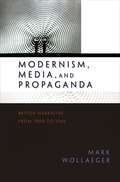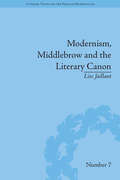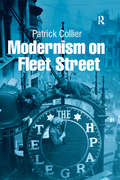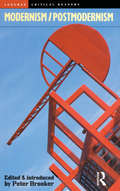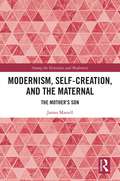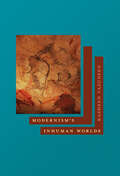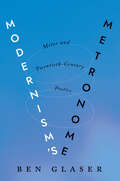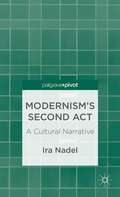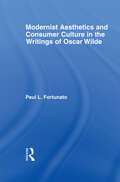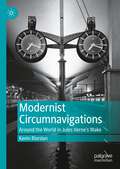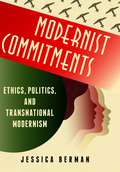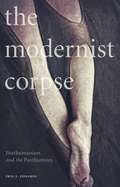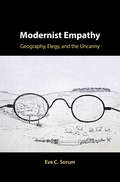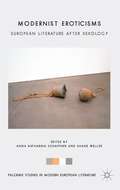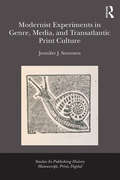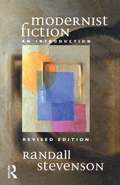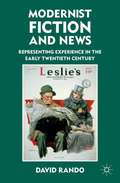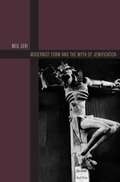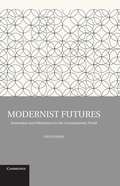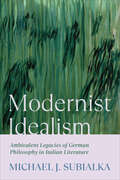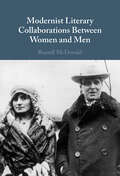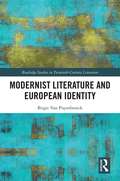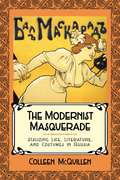- Table View
- List View
Modernism, Male Friendship, And The First World War
by Sarah ColeSarah Cole examines the rich literary and cultural history of masculine intimacy in the twentieth century. Cole approaches this complex and neglected topic from many perspectives - as a reflection of the exceptional social power wielded by the institutions that housed and structured male bonds; as a matter of closeted and thwarted homoerotics; as part of the story of the First World War. Cole shows that the terrain of masculine fellowship provides an important context for understanding key literary features of the modernist period. She foregrounds such crucial themes as the over-determined relations between imperial wanderers in Conrad's tales, the broken friendships that permeate Forster's fictions, Lawrence's desperate urge to make culture out of blood brotherhood and the intense bereavement of the war poet. Cole argues that these dramas of compelling and often tortured male friendship have helped to define a particular spirit and voice within the literary canon.
Modernism, Media, and Propaganda: British Narrative from 1900 to 1945
by Mark WollaegerThough often defined as having opposite aims, means, and effects, modernism and modern propaganda developed at the same time and influenced each other in surprising ways. The professional propagandist emerged as one kind of information specialist, the modernist writer as another. Britain was particularly important to this double history. By secretly hiring well-known writers and intellectuals to write for the government and by exploiting their control of new global information systems, the British in World War I invented a new template for the manipulation of information that remains with us to this day. Making a persuasive case for the importance of understanding modernism in the context of the history of modern propaganda, Modernism, Media, and Propaganda also helps explain the origins of today's highly propagandized world. Modernism, Media, and Propaganda integrates new archival research with fresh interpretations of British fiction and film to provide a comprehensive cultural history of the relationship between modernism and propaganda in Britain during the first half of the twentieth century. From works by Joseph Conrad to propaganda films by Alfred Hitchcock and Orson Welles, Mark Wollaeger traces the transition from literary to cinematic propaganda while offering compelling close readings of major fiction by Virginia Woolf, Ford Madox Ford, and James Joyce.
Modernism, Middlebrow and the Literary Canon: The Modern Library Series, 1917–1955 (Literary Texts and the Popular Marketplace #7)
by Lise JaillantIn the 1920s and 1930s the Modern Library series began to bring out cheap editions of modernist works. Jaillant provides a thorough analysis of the series’ mix of highbrow and popular literature and argues that the availability and low cost of modernist works helped to expand modernism's influence as a literary movement.
Modernism on Fleet Street
by Patrick CollierBritish modernism came of age at a time of great cultural anxiety about the state of journalism. The new newspapers, with their brief, flashy articles, striking visuals, hyperbolic headlines, and sensational news, stood at the center of debates about reading in the period, seeming to threaten the viability of representative democracy, the health and vitality of the language, and the very future of literature itself. Patrick Collier's study brings an impressive array of archival research to his exploration of modernism's relationship to the newspaper press. People who sought to make their way as writers could neither remain neutral on this issue nor abandon journalism, which offered an irreplaceable source of income and self-advertisement. Collier discusses five modern writers-T. S. Eliot, James Joyce, Virginia Woolf, Rebecca West, and Rose Macaulay-showing how their work takes part in contemporary debates about journalism and examining the role journalism played in establishing their careers. In doing so, he uncovers tensions and contradictions inherent in the identity of the 'serious artist' who relied on the ephemeral forms of journalism for money and reputation.
Modernism/Postmodernism (Longman Critical Readers)
by Peter BrookerThe concepts of 'Modernism' and 'Postmodernism' constitute the single most dominant issue of twentieth-century literature and culture and are the cause of much debate. In this influential volume, Peter Brooker presents some of the key viewpoints from a variety of major critics and sets these additionally alongside challenging arguments from Third World, Black and Feminist perspectives. His excellent Introduction and detailed headnotes for each section and essay provide an indispensable guide to interpreting the many different opinions, and prove to be valuable contributions in their own right.
Modernism, Self-Creation, and the Maternal: The Mother’s Son (Among the Victorians and Modernists)
by James MartellFocusing on their conception and use of the notion of the mother, Modernism, Self-Creation, and the Maternal proposes a new interpretation of literature by modernist authors like Rousseau, Baudelaire, Poe, Rimbaud, Rilke, Joyce, and Beckett. Seen through this maternal relation, their writing appears as the product of an "anxiety" rising not from paternal influence, but from the violence done to their mother in their attempts at self-creation through writing. In order to bring to light this modernist violence, this study analyzes these authors in tandem with Derrida’s work on the gender-specific violence of the Western philosophical and literary tradition. The book demonstrates how these writer-sons wrote their works in a constant crisis vis-à-vis the mother’s body as site of both origin and dissolution. It proves how, if modernism was first established as a patrilineal heritage, it was ultimately written on the bodies of women and mothers, confusing them in order to appropriate their generative traits.
Modernism's Inhuman Worlds
by Rasheed TazudeenModernism's Inhuman Worlds explores the centrality of ecological precarity, species indeterminacy, planetary change, and the specter of extinction to modernist and contemporary metamodernist literatures. Modernist ecologies, Rasheed Tazudeen argues, emerge in response to the enigma of how to imagine inhuman being—including soils, forests, oceans, and the earth itself—through languages and epistemologies that have only ever been humanist. How might (meta)modernist aesthetics help us to imagine (with) inhuman worlds, including the worlds still to be made on the other side of mass extinction? Through innovative readings of canonical and emergent modernist and metamodernist works, Tazudeen theorizes inhuman modernism as a call toward further receptivity to the worlds, beings, and relations that tend to go unthought within Western humanist epistemologies. Modernist engagements with the figures of enigma, riddle, and metaphor, according to the book's central argument, offer a means toward what Franz Kafka calls an "otherwise" speaking, based on language's obliqueness to inhuman and planetary being. Drawing on ecocriticism, decolonial and feminist science studies, postcolonial theory, inhuman geography, and sound studies, Tazudeen analyzes an inhuman modernist lineage—spanning from Darwin, Carroll, and Flaubert, through Joyce, Kafka, and Woolf, to contemporary poetic works—as both part of a collaborative rethinking of modernism's planetary and inhuman aesthetics, as well as occasions for imagining new modes of livingness for the extinctions to come.
Modernism's Metronome: Meter and Twentieth-Century Poetics (Hopkins Studies in Modernism)
by Ben GlaserDespite meter's recasting as a rigid metronome, diverse modern poet-critics refused the formal ideologies of free verse through complex engagements with traditional versification.In the twentieth century, meter became an object of disdain, reimagined as an automated metronome to be transcended by new rhythmic practices of free verse. Yet meter remained in the archives, poems, letters, and pedagogy of modern poets and critics. In Modernism's Metronome, Ben Glaser revisits early twentieth-century poetics to uncover a wide range of metrical practice and theory, upending our inherited story about the "breaking" of meter and rise of free verse.
Modernism’s Second Act: A Cultural Narrative
by Ira NadelEuropean modernism underwent a massive change from 1930 to 1960, as war altered the cultural landscape. This account of artists and writers in France and England explores how modernism survived under authoritarianism, whether Fascism, National Socialism, or Stalinism, and how these artists endured by balancing complicity and resistance.
Modernist Aesthetics and Consumer Culture in the Writings of Oscar Wilde (Studies in Major Literary Authors)
by Paul FortunatoOscar Wilde was a consumer modernist. His modernist aesthetics drove him into the heart of the mass culture industries of 1890s London, particularly the journalism and popular theatre industries. Wilde was extremely active in these industries: as a journalist at the Pall Mall Gazette; as magazine editor of the Women’s World; as commentator on dress and design through both of these; and finally as a fabulously popular playwright. Because of his desire to impact a mass audience, the primary elements of Wilde’s consumer aesthetic were superficial ornament and ephemeral public image – both of which he linked to the theatrical. This concern with the surface and with the ephemeral was, ironically, a foundational element of what became twentieth-century modernism – thus we can call Wilde’s aesthetic a consumer modernism, a root and branch of modernism that was largely erased.
Modernist Circumnavigations: Around the World in Jules Verne's Wake
by Kevin RiordanThis book shows how Jules Verne’s Around the World in Eighty Days changed the global imagination. Through his novel, the world was converted into a personal itinerary, scaled to the individual traveller and, by extension, to the individual reader. Exploring Verne’s modern legacy, this study shows how subsequent generations of artists and writers took on Around the World in Eighty Days as an adaptable guidebook to the modern world. It investigates how Verne’s work leads its reader beyond the book itself. It considers Verne’s place in world literature, traces some of the many real reenactments of Verne’s itinerary, and recalls the theatrical adaptations of Verne’s story. Published to coincide with the 500th anniversary of the first circumnavigation and the 150th anniversary of Verne’s novel, this book offers new insights into the largely overlooked influence of Verne on twentieth-century literature and culture and on the field of global modernism.
Modernist Commitments: Ethics, Politics, and Transnational Modernism (Modernist Latitudes)
by Jessica BermanJessica Berman demonstrates how modernist narrative connects ethical attitudes and responsibilities to the active creation of political relationships and the way we imagine justice. She challenges divisions between "modernist" and "committed" writing, arguing that a continuum of political engagement undergirds modernisms worldwide and that it is strengthened rather than hindered by formal experimentation. In addition to making the case for a transnational model of modernism, Berman shows how modernism's play with formal matters, its challenge to the boundaries between fact and fiction, its incorporation of vernacular and folkways, and its engagement with embodied experience and intimacy offer not only an expanded account of modernist texts and commitments but a new way of thinking about what modernism is and can do.
The Modernist Corpse: Posthumanism and the Posthumous
by Erin E. EdwardsAn unconventional take on the corpse challenges traditional conceptions of who—and what—counts as human, while offering bold insights into the modernist project Too often regarded as the macabre endpoint of life, the corpse is rarely discussed and largely kept out of the public eye. In The Modernist Corpse, Erin E. Edwards unearths the critically important but previously buried life of the corpse, which occupies a unique place between biology and technology, the living and the dead. Exploring the posthumous as the posthuman, Edwards argues that the corpse is central to understanding relations between the human and its &“others,&” including the animal, the machine, and the thing.From photographs of lynchings to documentation of World War I casualties, the corpse is also central to the modernist project. Edwards turns critical attention to the corpse through innovative, posthumanist readings of canonical thinkers such as William Faulkner, Jean Toomer, W. E. B. Du Bois, Mina Loy, Djuna Barnes, and Gertrude Stein, offering new insights into the intersections among race, gender, technical media, and matter presumed to be dead. Edwards&’s expansive approach to modernism includes diverse materials such as Hollywood film, experimental photography, autopsy discourses, and the comic strip Krazy Kat, producing a provocatively broad understanding of the modernist corpse and its various &“lives.&”The Modernist Corpse both establishes important new directions for modernist inquiry and overturns common thought about the relationship between living and dead matter.
Modernist Empathy: Geography, Elegy, and the Uncanny
by Eve C. SorumThis book shows how reading modernist literature gives us a fresh and necessary insight into both the tensions within the empathetic imagination and the idea of empathy itself. Writers such as Thomas Hardy, Ford Madox Ford, Mary Borden, T. S. Eliot, and Virginia Woolf encourage us to enter other perspectives even as they question the boundaries between self and other and, hence, the very possibility of empathy. Eve Sorum maintains that we must think through this complex literary heritage, focusing on the geographic and elegiac modes of the empathetic imagination, and revealing empathy as more fraught, threatening, and even uncanny than it first appears. Modernist Empathy thereby forges a theory of literary empathy as an act not of orientation, but of disorientation, thereby enriching our contemporary understanding of both modernist literature and the concept of literary empathy.
Modernist Eroticisms
by European LiteratureThis volume explores the impact of sexological and early psychoanalytic conceptions of sexual perversion on the representation of the erotic in the work of a range of major European modernists (including Joyce, Kafka, Lawrence, Mann, Proust and Rilke) as well as in that of some less-well-known figures of the period such as Dujardin and Jahnn.
Modernist Experiments in Genre, Media, and Transatlantic Print Culture (Studies in Publishing History: Manuscript, Print, Digital)
by Jennifer Julia SorensenThe years from 1890 through 1935 witnessed an explosion of print, both in terms of the variety of venues for publication and in the vast circulation figures and the quantity of print forums. Arguing that the formal strategies of modernist texts can only be fully understood in the context of the material forms and circuits of print culture through which they were produced and distributed, Jennifer Sorensen shows how authors and publishers conceptualized the material text as an object, as a body, and as an ontological problem. She examines works by Henry James, Jean Toomer, Djuna Barnes, Katherine Mansfield, and Virginia Woolf, showing that they understood acts of reading as materially mediated encounters. Sorensen draws on recent textual theory, media theory, archival materials, and paratexts such as advertisements, illustrations, book designs, drafts, diaries, dust jackets, notes, and frontispieces, to demonstrate how these writers radically redefined literary genres and refashioned the material forms through which their literary experiments reached the public. Placing the literary text at the center of inquiry while simultaneously expanding the boundaries of what counts as that, Sorensen shows that modernist generic and formal experimentation was deeply engaged with specific print histories that generated competitive media ecologies of competition and hybridization.
Modernist Fiction: An Introduction
by R. W. StevensonIn the revised edition of this popular text, Randall Stevenson has expanded, re-emphasised and amended his work to make it even more relevant to today's student studying the Modernist period in literature. The book covers a wide range of modernist novelists and novels, and also provides an invaluable guide to key developments in the genre. Stevenson has developed his text by adding a discussion of Conrad's Heart of Darkness, which is now taught more regularly than Lord Jim. In addition he takes a fresh look at the politics of the Modernists, in conjunction with the politics of their texts, pointing out the drawbacks of politically-progressive readings of many modernist novels. Finally, in the section on gender, Stevenson includes discussions of such significant figures as Djuna Barnes, HD, Katherine Mansfield and Rebecca West, as well as expanding the reference to Gertrude Stein throughout. The revisions in this updated text serve to make the authors' arguments sharper and allow the text to remain central to the discussion of modernism, modernity and the novel.
Modernist Fiction and News
by David Rando"Modernist Fiction and News "characterizes modernism in terms of its intimate, creative, and experimental relationship with a newly reorganized and rapidly expanding news industry. Writers such as Gertrude Stein, James Joyce, John Dos Passos, and Virginia Woolf engage with the discourse and narratives of the news in order to establish an experimental space in which to represent experience with the hope of greater immediacy and faithfulness to reality. "
Modernist Fiction and Vagueness
by Megan QuigleyModernist Fiction and Vagueness marries the artistic and philosophical versions of vagueness, linking the development of literary modernism to changes in philosophy. This book argues that the problem of vagueness - language's unavoidable imprecision - led to transformations in both fiction and philosophy in the early twentieth century. Both twentieth-century philosophers and their literary counterparts (including James, Eliot, Woolf, and Joyce) were fascinated by the vagueness of words and the dream of creating a perfectly precise language. Building on recent interest in the connections among analytic philosophy, pragmatism, and modern literature, Modernist Fiction and Vagueness demonstrates that vagueness should be read not as an artistic problem but as a defining quality of modernist fiction.
Modernist Form and the Myth of Jewification
by Neil LeviWhy were modernist works of art, literature, and music that were neither by nor about Jews nevertheless interpreted as Jewish? In this book, Neil Levi explores how the antisemitic fantasy of a mobile, dangerous, contagious Jewish spirit unfolds in the antimodernist polemics of Richard Wagner, Max Nordau, Wyndham Lewis, and Louis-Ferdinand Celine, reaching its apotheosis in the notorious 1937 Nazi exhibition “Degenerate Art.” Levi then turns to James Joyce, Theodor W. Adorno, and Samuel Beckett, offering radical new interpretations of these modernist authors to show how each presents his own poetics as a self-conscious departure from the modern antisemitic imaginary.Levi claims that, just as antisemites once feared their own contamination by a mobile, polluting Jewish spirit, so too much of postwar thought remains governed by the fear that it might be contaminated by the spirit of antisemitism. Thus he argues for the need to confront and work through our own fantasies and projections—not only about the figure of the Jew but also about that of the antisemite.
Modernist Futures
by David JamesIn Modernist Futures, David James examines the implications of modernism's continuity in late twentieth- and twenty-first-century writing by tracing its political and ethical valences in emerging novelistic practices. Focusing on the work of J. M. Coetzee, Milan Kundera, Ian McEwan, Toni Morrison, Michael Ondaatje, and Phillip Roth, James reconsiders the purpose of literary innovation as it relates to the artistic and cultural interventions such writers perform. By rethinking critical and disciplinary parameters, James brings scholarship on contemporary fiction into dialogue with modernist studies, offering a nuanced account of narrative strategies that sheds new light on the form of the novel today. An ambitious and incisive contribution to the field, this book will appeal especially to scholars of modernism and contemporary literary culture as well as those in American and postcolonial studies.
Modernist Idealism: Ambivalent Legacies of German Philosophy in Italian Literature (Toronto Italian Studies)
by Michael J. SubialkaOffering a new approach to the intersection of literature and philosophy, Modernist Idealism contends that certain models of idealist thought require artistic form for their full development and that modernism realizes philosophical idealism in aesthetic form. This comparative view of modernism employs tools from intellectual history, literary analysis, and philosophical critique, focusing on the Italian reception of German idealist thought from the mid-1800s to the Second World War. Modernist Idealism intervenes in ongoing debates about the nineteenth- and twentieth-century resurgence of materialism and spiritualism, as well as the relation of decadent, avant-garde, and modernist production. Michael J. Subialka aims to open new discursive space for the philosophical study of modernist literary and visual culture, considering not only philosophical and literary texts but also early cinema. The author’s main contention is that, in various media and with sometimes radically different political and cultural aims, a host of modernist artists and thinkers can be seen as sharing in a project to realize idealist philosophical worldviews in aesthetic form.
Modernist Literary Collaborations Between Women and Men
by Russell McDonaldMajor figures including W. B. Yeats, Marianne Moore, D. H. Lawrence, Ford Madox Ford, and Virginia Woolf viewed 'cross-sex' collaboration as a valuable, and often subversive, strategy for bringing women and men's differing perspectives into productive dialogue while harnessing the creative potential of gendered discord. This study is the first to acknowledge collaboration between women and men as an important part of the modernist effort to 'make it new.' Drawing on current methods from textual scholarship to read modernist texts as material, socially constructed products of multiple hands, the study argues that cross-sex collaboration involved writers working not just with each other, but also with publishers and illustrators. By documenting and tracing the contours of their desire for cross-sex collaboration, we gain a new understanding of the modernists' thinking about sex and gender relations, as well as three related topics of great interest to them: marriage, androgyny, and genius.
Modernist Literature and European Identity (Routledge Studies in Twentieth-Century Literature)
by Birgit Van PuymbroeckModernist Literature and European Identity examines how European and non-European authors debated the idea of Europe in the first half of the twentieth century. It shifts the focus from European modernism to modernist Europe, and shows how the notion of Europe was constructed in a variety of modernist texts. Authors such as Ford Madox Ford, T. S. Eliot, Gertrude Stein, Aimé Césaire, and Nancy Cunard each developed their own notion of Europe. They engaged in transnational networks and experimented with new forms of writing, supporting or challenging a European ideal. Building on insights gained from global modernism and network theory, this book suggests that rather than defining Europe through a set of core principles, we may also regard it as an open or weak construct, a crossroads where different authors and views converged and collided.
The Modernist Masquerade
by Colleen McquillenMasked and costume balls thrived in Russia in the late nineteenth and early twentieth centuries during a period of rich literary and theatrical experimentation. The first study of its kind, The Modernist Masquerade examines the cultural history of masquerades in Russia and their representations in influential literary works. The masquerade's widespread appearance as a literary motif in works by such writers as Anna Akhmatova, Leonid Andreev, Andrei Bely, Aleksandr Blok, and Fyodor Sologub mirrored its popularity as a leisure-time activity and illuminated its integral role in the Russian modernist creative consciousness. Colleen McQuillen charts how the political, cultural, and personal significance of lavish costumes and other forms of self-stylizing evolved in Russia over time. She shows how their representations in literature engaged in dialog with the diverse aesthetic trends of Decadence, Symbolism, and Futurism and with the era's artistic philosophies.

